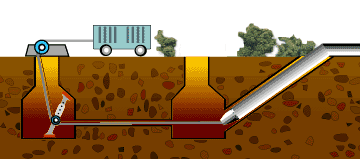Trenchless replacement of communications
Trenchless replacement of old pipes with new ones is carried out during the reconstruction or overhaul of existing underground utility networks in the conditions of urban development and on the territory of enterprises. The developed technology allows a trenchless method to replace steel, cast iron and non-metallic pipelines from 100 mm to 350 mm in diameter, with plastic pipes from 160 mm to 400 mm in diameter. The essence of the technology lies in the fact that a special extension nozzle is mounted on the shock mechanism placed in the inlet well. An air-supply hose and a cable from the winch connects to the machine, passing through the replaced section of the pipeline. When the device moves through the replaced pipeline, the expander breaks it, taps the fragments into the ground and tightens a new pipeline into the newly formed well, which is built up by sections in the inlet well.
Equipment used:
- A pneumatic impact machine of required diameter
- Expander
- Anchor device
- A pneumatic winch with a pulling force of 3t or 5t
- Device for connecting plastic pipes
- A set of air hoses
- A set of tools and spare parts
Diagram of trenchless replacement of emergency pipelines:
Principle of operation of a pneumatic impact machine:
Trenchless replacement of water supply networks
When laying water pipes, sections of polyethylene pipes are welded to the surface in the whip. According to the previously formed inclined assembly well, the sections fall into the pit and then into the expanded well. A special starting installation is needed for the drilling of the assembly well.
The technology and the equipment kits are designed for trenchless laying of new sections of sewage and water supply networks. First, the leading well passes between the pits, where future wells are going to be. In the borehole a traction cable is made, which at one end is connected to the winch (mounted on the outlet well), and the other, to the pneumatic hammer. On the front of the pneumatic hammer there is an expander with a device for fixing a new plastic pipeline to it. When compressed air is supplied first to the winch, and then to the pneumatic hammer, the equipment begins to transfer the shock load to the soil massif and seal it, expanding the leading well. While laying sewer networks in a newly formed well a plastic pipeline is tightened. Separate sections of the pipeline with the help of threaded connections are built up in the entrance pit.

Equipment used:
- A pneumatic impact machine of required diameter
- Expander
- Anchor device
- Pneumatic winch with a pulling force of 3t or 5t
- Device for connecting plastic pipes
- A set of air hoses
- A set of tools and spare parts

 GE
GE RU
RU EN
EN